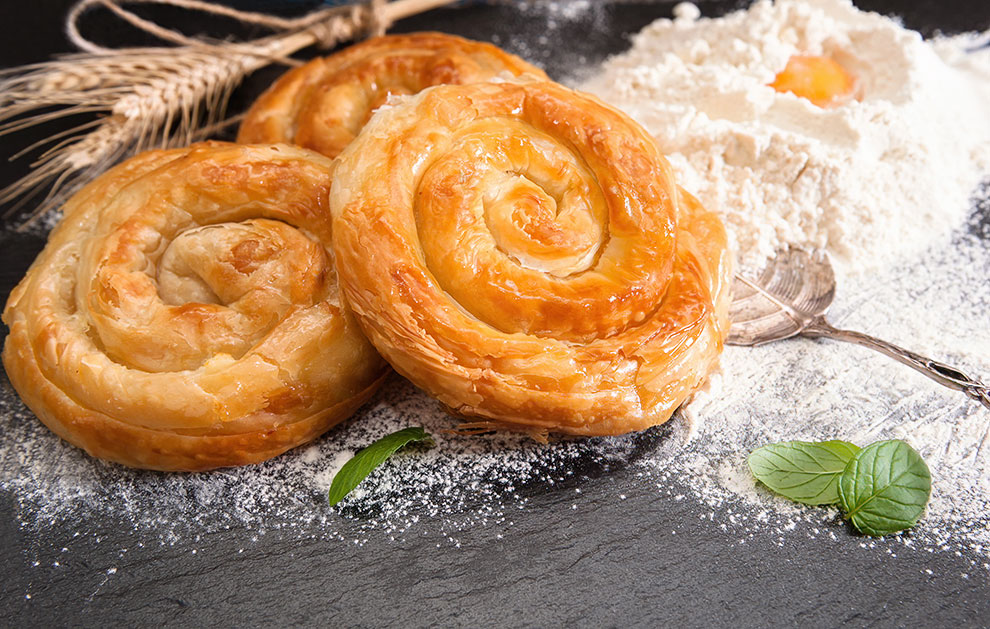Bulgarian rolled banitsa (вита баница) is a delicious, spiraled variation of the traditional layered banitsa. It is made by rolling thin phyllo sheets around a rich mixture of Bulgarian white cheese (sirene), eggs, and yogurt. The dough is then arranged in a circular pattern, creating a beautifully crisp, golden pastry with a soft and cheesy interior.
Unlike the flat-layered Bulgarian banitsa, this version is more compact, holds its shape well, and is perfect for slicing into individual portions. It is commonly enjoyed for breakfast, as a snack, or during festive occasions, often paired with Bulgarian yogurt or ayran (savory yogurt drink).
Preparation Time
- Prep Time: 20 minutes
- Cook Time: 40–45 minutes
- Total Time: 1 hour 5 minutes
Ingredients (For Four People)
- Phyllo dough – 400 g (14 oz), thin sheets
- Bulgarian white cheese (sirene) – 300 g (10 oz)
- Crumbled Eggs – 3 to 4 (divided; see steps below)
- Yogurt – 200 g (7 oz) (optional for extra softness)
- Butter or oil – 100 g (3.5 oz), melted
- Baking soda – 1/2 tsp (if using yogurt
Note: 1 tablespoon is approximately 15 ml, and a teaspoon is approximately 5 ml.
Preparation Method: Bulgarian Rolled Banitsa
Step 1: Prepare the Cheese Filling
- Crumble the sirene (Bulgarian white cheese) into a bowl.
- Mix with some or all of the eggs and, if using, yogurt with baking soda for a fluffier texture.
- Option 1: Use all eggs in the filling for a richer consistency.
- Option 2: Save one egg for an egg-water wash in Step 4 to coat the rolled banitsa before baking.
Step 2: Fill and Roll the Phyllo Sheets
- Lay one sheet of phyllo dough on a clean surface.
- Brush lightly with melted butter or oil.
- Spread a few spoonfuls of the cheese mixture evenly over the sheet.
- Place another phyllo sheet on top and repeat the butter and cheese layering.
- Roll the stacked sheets into a long cylinder from one end to the other.
- Repeat with the remaining phyllo sheets and filling.
Step 3: Shape the Banitsa
- Grease a round baking pan with butter or oil.
- Place the first rolled strip in the pan’s center, forming a spiral shape.
- Continue adding the rolled strips around the first one, creating a coiled snail-like pattern.
Step 4: Prepare the Egg-Water Mixture
- If you saved an egg in Step 1, whisk it with a few tablespoons of water or milk.
- Brush this mixture evenly over the coiled banitsa, ensuring it soaks into the layers for moisture and crispness.
Step 5: Bake the Banitsa
- Preheat the oven to 180°C (350°F).
- Bake for 40–45 minutes or until the top is golden brown and crispy.
Step 6: Serve and Enjoy
- Let the banitsa cool for 5–10 minutes, then slice into individual portions.
- Serve warm, accompanied by Bulgarian yogurt or a glass of ayran.

Tips and Tricks
- Don’t oversaturate the filling – Too much moisture can make the dough soggy instead of flaky.
- Let the egg-water mixture soak in – This ensures a perfectly golden and slightly soft texture inside.
- Brush each sheet with butter or oil – This prevents dryness and helps achieve an even crisp.
Variations
- Traditional Bulgarian Layered (flat) Banitsa
- Spinach and Cheese Banitsa: For a more flavorful, nutritious twist, add sautéed spinach or Swiss chard to the filling.
- Pumpkin and Walnut Banitsa (Tikvenik): For a sweet variation, Replace the cheese with grated pumpkin, sugar, and crushed walnuts.
Serving Suggestions
Serve with Yogurt or Ayran – The creamy, tangy flavors complement the crispness of the pastry.
Nutritional Information (Per Serving, Approximate)
- Calories: 320 kcal
- Protein: 10 g
- Carbohydrates: 30 g
- Fat: 18 g
- Calcium: 15% of Daily Value
Note: Nutritional values vary depending on the type of cheese and yogurt used.
Storage Suggestions
- Refrigeration: Store in an airtight container for up to 3 days.
- Reheating: Warm in the oven at 160°C (320°F) for 10 minutes to maintain crispness.
- Freezing: It can be frozen before baking—simply wrap tightly and bake directly from frozen, adding 5–10 extra minutes to the baking time.
Cultural Context
Rolled banitsa, or вита баница, has been a staple in Bulgarian households for centuries, particularly during celebratory occasions and festive gatherings. Unlike the flat-layered banitsa, which can be prepared for New Year’s Eve with fortune slips inside, the rolled version is preferred for more compact, travel-friendly servings.
In many villages, homemade banitsa is a symbol of hospitality. Guests are often served fresh yogurt and a warm welcome. Banitsa is commonly enjoyed for breakfast, family gatherings, or holidays, keeping Bulgarian culture’s deep-rooted culinary tradition alive.


